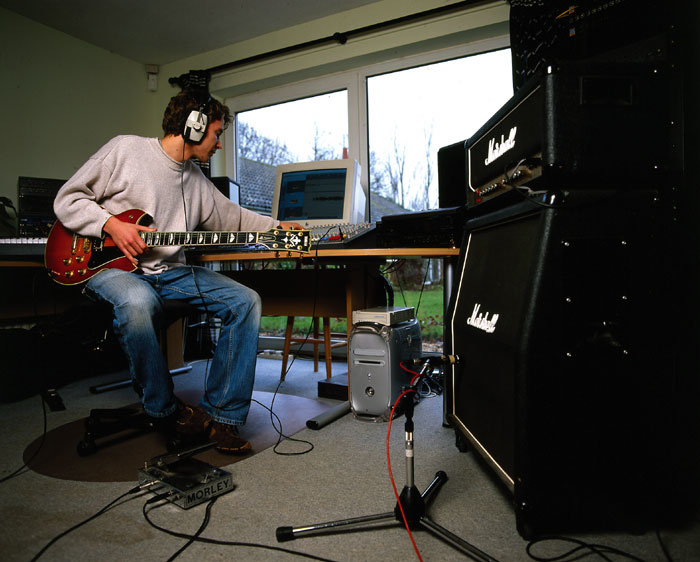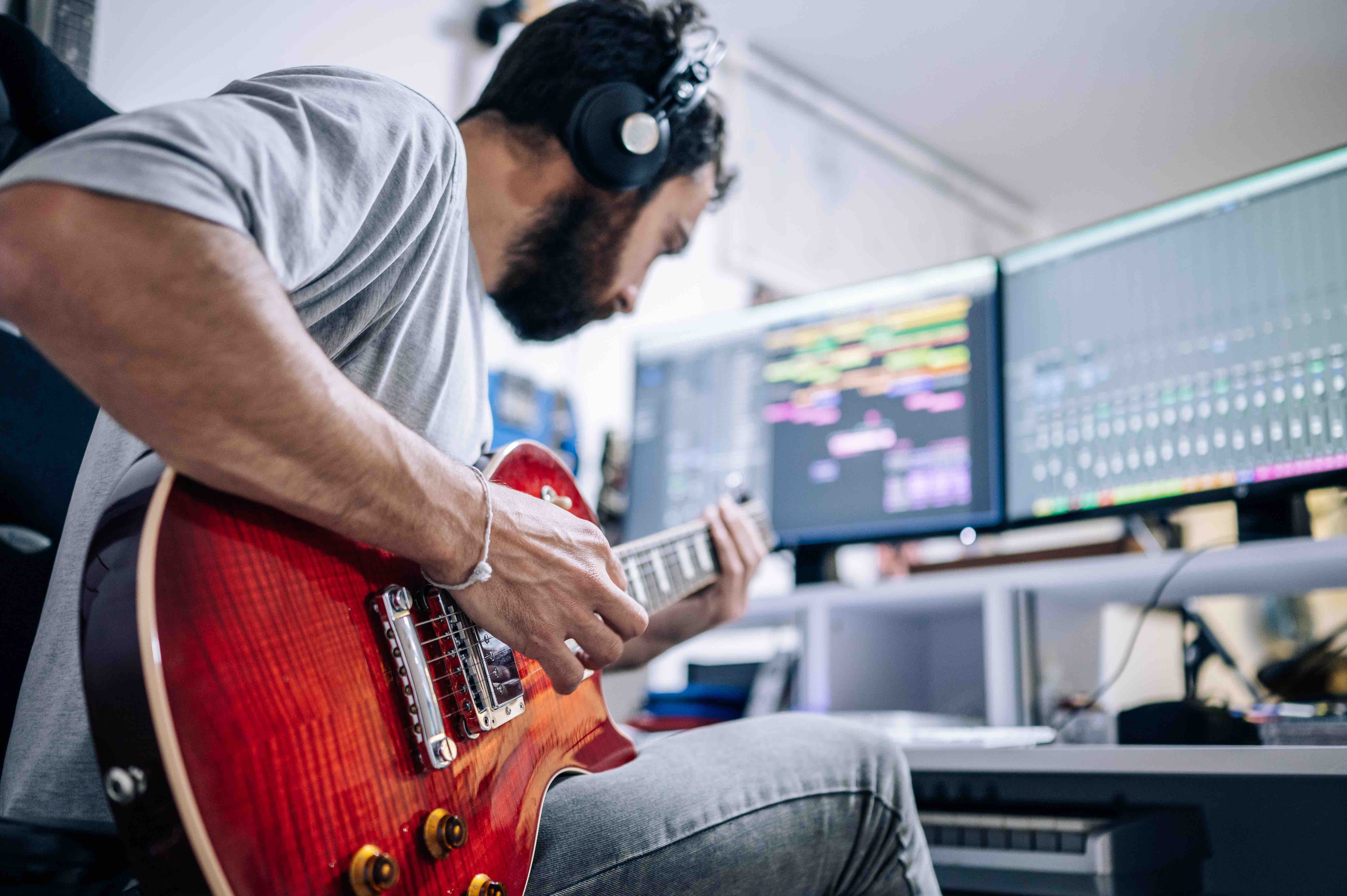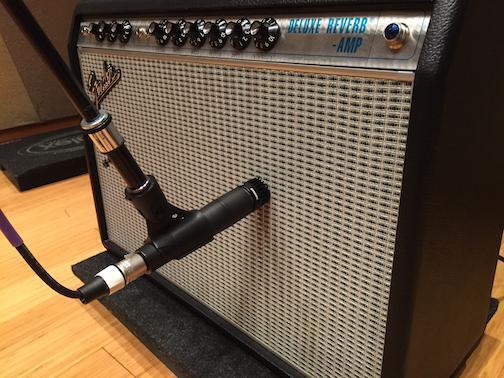The Fender Stratocaster is an iconic electric guitar best suited for studio recording. Its versatility ensures a wide range of tones for different musical genres.
Choosing the right electric guitar for recording is essential for capturing the perfect sound on your tracks. The Fender Stratocaster, with its clear, bell-like tones and wide sonic palette, is a staple in studios around the world. Whether you’re laying down rhythm sections or soaring solos, a Strat can accommodate almost any style of music.
Its triple pickup configuration and five-way switching offer a variety of tones, from sharp and cutting to warm and mellow. Guitarists appreciate the Strat’s comfortable playability and reliable tuning stability, both crucial for long recording sessions. With its widespread popularity, the Stratocaster’s sound is instantly recognizable, making it a top choice for artists looking to produce professional-quality recordings.

Credit: www.soundonsound.com
Understanding Electric Guitar Basics For Studio Work
When diving into the realm of studio recordings, the electric guitar you choose becomes an extension of your artistic voice. Selecting the right guitar is pivotal, as it not only complements your playing style but also influences the tonal quality of your recorded tracks. Let’s delve deep into the world of electric guitars, examining their structural differences, the significance of their components, and the impact on your studio work.
Differentiating Between Solid Body, Semi-hollow, And Hollow Body Guitars
Understanding the core variations among electric guitar types is essential for achieving the desired sound. Here’s a glance at the distinctive characteristics:
- Solid Body Guitars – Known for their durability and wide range of tones, suitable for genres like rock, metal, and pop.
- Semi-Hollow Guitars – These guitars offer a warm resonance that works well with jazz, blues, and rockabilly.
- Hollow Body Guitars – Revered for their rich, acoustic-like tones, ideal for jazz and softer rock genres.
The Importance Of Pickups In Recording: Single Coils Vs. Humbuckers
Pickups play a crucial role in defining the sound of an electric guitar. Here’s how they differ:
| Pickup Type | Tonal Characteristic | Genre Fit |
|---|---|---|
| Single Coils | Bright and crisp, with an articulate sound. | Favored in surf, country, and classic rock. |
| Humbuckers | Warm and full, with a noise-canceling feature. | Preferred for heavy rock, metal, and jazz. |
Scale Length And Neck Profiles: How They Impact Playability And Sound
The physical dimensions of a guitar neck influence both ergonomics and tonal properties:
- Scale Length – A longer scale length yields a brighter tone with more sustain, while a shorter scale provides a warmer tone with less tension.
- Neck Profiles – The shape of the neck affects the grip and comfort during play. A
C-shaped profile is universally comfortable, whereas aUorVprofile may suit specific playing styles.
A guitar with the right combination of scale length and neck profile enhances performance during recordings, facilitating both comfort and desired sound quality.
Choosing The Right Electric Guitar For Your Recording Needs
Every electric guitar has its own character, a unique voice that can either enhance a recording or detract from it. When selecting the perfect electric guitar for studio work, musicians and producers must weigh a variety of factors. From the genre of the music to the nuances of the guitar’s construction, every decision shapes the final sound. This guide will help in demystifying the process and ensure the guitar you choose is the perfect fit for your recording needs.
Assessing Your Genre: Matching Guitar Types To Music Styles
Finding the right guitar often starts with understanding its role within specific genres. Each type of electric guitar, with its distinctive features, can be closely associated with certain musical styles.
- Solid-body guitars are versatile and can handle anything from rock to pop.
- Semi-hollow and hollow-body guitars offer a warmer tone, favored in jazz, blues, and RB.
- A metal-oriented guitar, often with active pickups, suits heavier genres such as metal and hard rock.
Budget Considerations: Entry-level Vs. Professional Models
The debate between entry-level and professional electric guitars is an important budgetary consideration. While professional-grade instruments can be a significant investment, they typically provide superior tone, playability, and reliability in the studio.
| Aspect | Entry-Level Guitars | Professional Models |
|---|---|---|
| Cost | More affordable, less initial investment | Higher priced, potentially better long-term value |
| Construction Quality | Factory-made, possibly with lower-grade materials | Often handcrafted, using premium materials |
| Sound Quality | Sufficient for beginners, variable consistency | Consistently higher quality, studio-grade tone |
The Impact Of Wood Types And Construction On Tone
The tonewood of an electric guitar contributes significantly to its sound. Different woods offer varied warmth, brightness, and sustain.
- Mahogany is known for a warm, rich tone with plenty of sustain.
- Maple offers brightness and helps articulate higher frequencies.
- Alder and ash provide a balanced tone suitable for many styles.
Additionally, consider the guitar’s construction. A set-neck or neck-through design may offer more sustain than a bolt-on neck, influencing the instrument’s resonance in recordings.
Hardware And Electronics: Tailoring Your Sound For The Studio
Dialing in the perfect tone extends beyond the guitar’s body to its hardware and electronics.
- Different bridge types, from tremolos to hardtails, affect sustain and tuning stability.
- Pickups are crucial: single-coils offer bright, crisp sounds, while humbuckers provide a fuller, noise-free output.
- The guitar’s control layout, including the number of tone and volume knobs, allows for diverse sound shaping possibilities.
- Consider the flexibility of coil-splitting features for added tonal variety.
These components should complement your musical style and the desired sound for your recordings.
Recording Techniques And Best Practices
Embarking on the journey of recording your electric guitar is an exciting venture! With technology empowering musicians to produce studio-quality tracks at home, grasping the right recording techniques and best practices is pivotal. Here, we delve into the nuances of capturing that electrifying guitar tone and layering parts to create depth in your music.
Mic Placement And Room Acoustics: Capturing The Ideal Guitar Tone
Finding the sweet spot for microphone placement can make a world of difference in your recordings. Aiming a mic directly at the center of the speaker cone yields a brighter tone, while positioning it off-center produces a warmer sound. Experiment with distance as well—closer for a more direct sound, further away to capture room ambience.
Room acoustics cannot be overlooked. A room with good acoustic treatment will enhance the natural tone of the guitar, while a poorly treated space can introduce unwanted echoes and reverb. Absorption panels and diffusers are key to tailoring your recording environment.
Direct Input (di) Recording Vs. Mic’ing Amps: Pros And Cons
DI recording offers the cleanness and simplicity of plugging directly into your interface. Ideal for clean tones, it is a low-noise solution perfect for mixing flexibility.
- Pros:
- Consistent sound quality
- Less susceptible to room acoustics
- Ease of re-amping
- Cons:
- Lacks the character of an amp
- May feel less organic
Conversely, mic’ing a guitar amp captures the uniqueness of your amp’s sound, giving a more authentic feel to your recording.
- Pros:
- Natural amplifier dynamics
- Richer harmonic content
- Cons:
- Susceptible to room noise and acoustics
- Requires more setup and fine-tuning
The Role Of Guitar Effects And Pedals During Recording Sessions
Effects and pedals are a guitarist’s toolbox for shaping the perfect sound. When recording, these tools need careful consideration. Dialing in the right amount of reverb, delay, distortion, or modulation can either elevate a track or bury it in a mix.
Use effects judaciously. Record a clean signal simultaneously for greater mix control later on. And remember, while it’s possible to add effects in post-production, it’s nearly impossible to remove them once recorded.
Multi-tracking And Layering Guitar Parts For A Fuller Sound
Multi-tracking—the process of recording multiple takes of the same part—adds depth and body to your sound. Doubling rhythm parts or layering multiple lead lines can create a rich tapestry of sound, transforming a flat recording into a dynamic one.
- Record the same part with different guitars or amp settings to broaden the stereo image.
- Consider the use of harmonies or complementary parts to add interest and texture.
- Keep timing tight and be mindful of phase cancellation when layering identical parts.
Maintaining Your Electric Guitar For Optimal Recording Quality
Maintaining an electric guitar is essential to ensure you capture the cleanest, richest sound possible when recording. Guitars are delicate instruments that react to the environment and wear over time. A well-maintained guitar not only sounds better but also holds tuning longer, offering a more pleasurable and efficient recording experience. In the following sections, we’ll dive into the maintenance practices you should regularly perform to keep your electric guitar in prime recording condition.
Regular Setup And Intonation Adjustments
Ensuring your guitar is set up correctly is vital for optimal sound quality. A guitar’s setup includes adjusting the action (the height of the strings above the fretboard), neck relief, and intonation. These adjustments guarantee your instrument is comfortable to play and, more importantly, that it stays in tune across the entire fretboard. A poorly intonated guitar can significantly detract from the quality of your recordings.
- Check the action and adjust as needed for ease of play.
- Ensure the neck is straight with a slight relief to avoid buzzing strings.
- Regularly check the intonation and adjust the bridge saddles to correct any sharp or flat notes.
A professional setup twice a year is a good standard to follow, but players experiencing frequent tuning issues or a change in string gauge may require more frequent adjustments.
The Importance Of String Choice And Replacement
Selecting the right type of strings can make a marked difference in the sound of your recordings. The gauge, material, and coating of the strings can affect tone, playability, and longevity. Experiment with different strings to find the ones that best suit your playing style and the genre of music you’re recording.
- Consider lighter strings for bending notes and comfort or heavier strings for fuller tone.
- Choose the material based on the desired tone (nickel for a warmer sound, stainless steel for a brighter tone).
- Consider coated strings for extended life and reduced finger noise.
Proactive string replacement is key. Dull, dirty, or rusty strings not only diminish sound quality but can also cause intonation problems. Regularly changing strings ensures your guitar sounds its best.
Cleaning And Care To Prevent Unwanted Noise
A clean guitar is synonymous with a noise-free recording. Dust, grime, and corrosion can cause unwanted noise and static, which can be amplified in the recording. Basic cleaning should be part of your regular maintenance to avoid these issues.
- Wipe down strings after each use to remove oil and residue.
- Clean the fretboard with a soft cloth and suitable cleaner during string changes.
- Maintain the hardware, ensuring all connections are tight to prevent rattles and buzzes.
Attention to cleanliness not only maintains the aesthetics of your guitar but also its functionality, eliminating potential distractions in the recording booth.
Listening To The Masters: Iconic Recorded Guitar Sounds And How They Were Achieved
Exploring the world of electric guitars and recording techniques is akin to unraveling the threads of musical history. Each legendary track offers insight into the mastery of guitar tones that have defined generations. ‘Listening to the Masters: Iconic Recorded Guitar Sounds and How They Were Achieved’ delves into the nuances of what made those sounds unforgettable, offering both an homage to the classics and a blueprint for aspiring guitarists and producers.
Analyzing Classic Guitar Tracks And Their Recording Techniques
The raw, gritty riff of Keith Richards on “Satisfaction,” or the otherworldly wail of Jimi Hendrix’s “Voodoo Child” – these sounds resonate through the annals of music history. Achieving such iconic sounds involves understanding the precise blend of guitar model, amplifier, pedals, and recording equipment used.
- The Beatles‘ “Revolution” – John Lennon’s epiphone casino directly plugged into the board, resulting in a clipping, distorted sound that was groundbreaking.
- Jimmy Page with Led Zeppelin – Utilized “distant miking” techniques for a massive sound, often recording in unconventional acoustic spaces like stairwells.
- David Gilmour on Pink Floyd’s “Comfortably Numb” – A combination of Hiwatt amps and custom pedal settings producing celestial sustaining notes.
- Jack White – Reveres analogue gear, often utilizing plastic guitars like the Airline for a distinct garage rock sound.
- John Mayer – A master of tone, seen in his detailed pedalboard setup that sculpts his signature clean overdriven sounds.
- St. Vincent – Pushes boundaries through digital pedalboard wizardry and custom-made Ernie Ball Music Man guitars.
Modern Innovators: Emulating Contemporary Guitar Sounds
Today’s guitar heroes build on the past while forging new sonic territories. Jack White’s raucous tones, John Mayer’s smooth blues, or St. Vincent’s eclectic style represent the diverse palette of modern guitar sounds. These artists often combine vintage gear with modern technology for textures that are simultaneously classic and fresh.
The Evolution Of Guitar Recording Technology
Guitar recording has evolved from single-microphone setups to multilayered digital workstations. Understanding this journey is essential for sculpting tones that speak to listeners today.
| Time Period | Technological Advances |
|---|---|
| 1950s & 60s | Tube amplifiers, early multi-track recording |
| 1970s & 80s | Effects pedals proliferation, introduction of digital effects |
| 1990s to Present | Advanced digital recording software, amp simulators, and plugin effects |
Modern recording studios allow layering intricate guitar parts with precision while software like Ableton Live or Logic Pro X brings these possibilities to home studios.

Credit: carvinaudio.com

Credit: www.sweetwater.com
Can Guitartuna Help Me Choose the Right Electric Guitar for Recording?
Choosing the right electric guitar for recording can be a daunting task, but tools like Guitartuna enhance your decision-making process. Its features help assess sound quality and tuning precision, ensuring you select the best instrument for your needs. Trust in guitartuna electric guitar effectiveness to elevate your recordings.
Frequently Asked Questions Of What Electric Guitar For Recording
Which Guitar Is Best For Studio Recording?
The best guitar for studio recording depends on the desired sound. Acoustic guitars are great for clarity, whereas electric guitars offer versatility. Brands like Fender and Gibson are popular choices among professionals. Select a well-crafted instrument that suits the genre and tone you’re aiming for.
Can You Record An Electric Guitar Directly?
Yes, you can record an electric guitar directly by connecting it to an audio interface or using a DI (Direct Injection) box.
How Do You Record High Quality Electric Guitar?
To record high-quality electric guitar, choose a quality guitar and amp. Mic the amp with a suitable dynamic or condenser mic. Position the mic close to the amp’s speaker. Use a high-resolution audio interface. Balance levels to avoid distortion, ensuring a clean and clear recording.
Should I Record Electric Guitar In Mono Or Stereo?
Record electric guitar in mono to capture a clean, direct sound. Stereo can create depth but isn’t typically necessary for single guitar tracks.
Conclusion
Choosing the right electric guitar for recording is a pivotal decision for any musician. It shapes your sound and can inspire your creative process. Remember to consider tone quality, playability, and compatibility with your gear. Find your perfect match, and let the music you record speak for itself.
Keep strumming, keep shining!
{ “@context”: “https://schema.org”, “@type”: “FAQPage”, “mainEntity”: [ { “@type”: “Question”, “name”: “Which guitar is best for studio recording?”, “acceptedAnswer”: { “@type”: “Answer”, “text”: “The best guitar for studio recording depends on the desired sound. Acoustic guitars are great for clarity, whereas electric guitars offer versatility. Brands like Fender and Gibson are popular choices among professionals. Select a well-crafted instrument that suits the genre and tone you’re aiming for.” } } , { “@type”: “Question”, “name”: “Can you record an electric guitar directly?”, “acceptedAnswer”: { “@type”: “Answer”, “text”: “Yes, you can record an electric guitar directly by connecting it to an audio interface or using a DI (Direct Injection) box.” } } , { “@type”: “Question”, “name”: “How do you record high quality electric guitar?”, “acceptedAnswer”: { “@type”: “Answer”, “text”: “To record high-quality electric guitar, choose a quality guitar and amp. Mic the amp with a suitable dynamic or condenser mic. Position the mic close to the amp’s speaker. Use a high-resolution audio interface. Balance levels to avoid distortion, ensuring a clean and clear recording.” } } , { “@type”: “Question”, “name”: “Should I record electric guitar in mono or stereo?”, “acceptedAnswer”: { “@type”: “Answer”, “text”: “Record electric guitar in mono to capture a clean, direct sound. Stereo can create depth but isn’t typically necessary for single guitar tracks.” } } ] }
